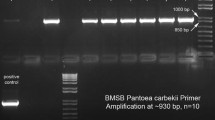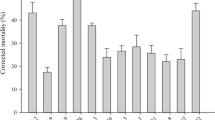Abstract
Laboratory studies using commercial formulations of mancozeb and dithianon at concentrations equivalent to recommended field rates of 200 and 80 g/hl, respectively, were conducted to evaluate toxic effects of these fungicides on the predatory miteAmblyseius andersoni Chant. In short-term tests where females were placed on apple-leaf disks and sprayed with mancozeb, no mortality of adults was observed; however, there was a 34% decrease in fecundity, a 7.1% decrease in egg hatch, and mortality of larvae and protonymphs was 6.7%. In long-term tests, a significant reduction in fecundity was also observed. A decrease in hatch that was dependent on age at time of treatment was found when eggs were treated directly with mancozeb. No effects on mite mortality or reproduction were observed in short-term tests with dithianon. These results suggest that dithianon might be considered as a potential alternative to mancozeb for scab control.
Similar content being viewed by others
References
Abbott, W., 1925. A method of computing the effectiveness of an insecticides. J. Econ. Entomol., 18: 265–267.
Baillod, M. and Guignard, E., 1984. Résistance deTyphlodromus pyri Scheuten à l'azinfos et lutte biologiques contre les acariens phytophages en arboriculture. Rev. Suisse Vitic. Arboric. Hortic., 16 (3): 155–160.
Baynon, G.T. and Penman, D.R., 1987. The effects of mancozeb and metiram on the predatory mite,Typhlodromus pyri. Proceeding of the New Zealand Weed and Pest Control Conference, 1: 104–107.
Blommers, L., Alkema, P. and de Reede, R., 1986. The effects of pesticides and other spraying material on the predacious miteTyplodromus pyri. Bull. SROP, 9 (3): 60–62.
Burgerjon, A., 1956. Pulverisation et poudrage au laboratoire par des préparations pathogènes insecticides. Ann. Epiphyt., 4: 675–684.
Duso, C., Girolami, V., Borgo, M. and Egger, F., 1983. Influenza di anticrittogamici diversi sulla sopravvivenza di predatori fitoseidi introdotti su vite. Redia, 66: 469–483.
Forti, D., Ioriatti, C. and Delaiti, M., 1990. Valutazione dell'effetto collaterale di alcuni insetticidi regolatori di crescita sull'acaro predatoreAmblyseius andersoni Chant (Acari Fitoseidi). Atti Giornate Fitopatol, 1: 459–468.
Fungo, N.K. and Curry, J.P., 1983. The effects of eight fungicides on the glasshouse spider mite (Tetranychus urticae Koch). J. Life Sci. R. Dublin Soc., 4 (2): 175–181.
Hagley, E.A.C. and Biggs, A.R., 1989. Effects of three fungicides on populations of a phytophagous and several predacious mites (Acarina) on apple. Exp. Appl. Acarol., 6: 253–256.
Hassan, S.A., 1985. Standard methods to test the side-effects of pesticides on natural enemies of insects and mites developed by IOBC/WPRS Working Group ‘Pesticides and Beneficial Organisms’. Bull. OEPP/EPPO, 15 (1): 214–255.
Ioriatti, C. and Mattedi, L., 1988. Predatori del ragno rosso in Trentino, specie presenti, biologia e capacità di contenimento. Terra Trentina, 1: 28–31.
Ivancich Gambaro, P., 1972. I trattamenti fungicidi e gli acari della vite. Informatore Agrario, 8: 8141–8143.
Ivancich Gambaro, P., 1973. Il ruolo delTyphlodromus aberrans Oud (Acarina Phytoseidae) nel controllo biologico degli Acari fitofagi dei vigneti del veronese. Boll. Zool. Agr. Bachic. Ser. Il, 11: 151–165.
Mantinger, H., Vigl, J. and Epp, P., 1987. Nebenwirkung von Fungiziden auf Raubmilben. Obstbau Weinbau, 24 (1): 10–11.
Marchal-Segault, D., 1989. Toxicité de fongicides commerciaux vis-a-vis des larves deDrosophila melanogaster Meigen (Diptera, Drosophilidae) et incidence sur la sex ratio. J. Environ. Sci. Health, B24 (4): 307–324.
Marchesini, E., 1989. Effetti collaterali di antiperonosporici diversi suKampimodromus aberrans. Informatore Agrario, 55 (12): 111–114.
Mitlin, N. and Baroody, A.M., 1958. The effect of some biologically active compounds on growth of house fly ovaries. J. Econ. Entomol., 51: 384–385.
Overmeer, W.P.J. and Van Zon, A.Q., 1982. A standardized method for testing the side effects of pesticides on the predacious mite,Amblyseius potentille (Acarina: Phytoseiidae). Entomophaga, 27 (4): 357–364.
Stäubli, A. and Baillod, M., 1988. Les effets secondaires des pesticides sur les auxiliares: exemples pratiques en arboriculture et en viticulture. Rev. Suisse Vitic. Arboric. Hortic., 20 (4): 205–209.
Vigl, J., 1986. Nebenwirkungen einiger Schorfmittel auf Raub-und Spinnmilben. Obstbau Weinbau, 23 (4): 98–101.
Varner, M., Mattedi, L., Fellin, F., Forti, D., Rizzi, C. and Baldo, B., 1990. Ticchiolatura al lentino. Terra Trentina, 3: 45–54.
Author information
Authors and Affiliations
Rights and permissions
About this article
Cite this article
Ioriatti, C., Pasqualini, E. & Toniolli, A. Effects of the fungicides mancozed and dithianon on mortality and reproduction of the predatory miteAmblyseius andersoni . Exp Appl Acarol 15, 109–116 (1992). https://doi.org/10.1007/BF01275521
Received:
Issue Date:
DOI: https://doi.org/10.1007/BF01275521




